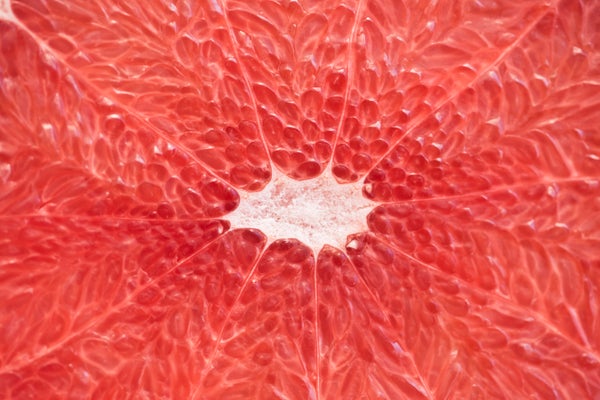This article was published in Scientific American’s former blog network and reflects the views of the author, not necessarily those of Scientific American
I taught a topology and geometry class this semester, and one of the topics we covered was spherical geometry. One of the interesting properties of spherical geometry is the fact that on a given sphere, the angles in a triangle completely determine the side lengths and area of the triangle. (If you find this rather upsetting, you’re not alone. Eighteenth-century Swiss mathematician Johann Lambert didn’t like it either.)
We did an activity with grapefruits and hair elastics to figure out the area of a spherical triangle based on its angles. I used grapefruits because they're large enough that you can really see what's going on and their bumpy skin helps the elastics stay on, but other spherical objects would also work. Likewise, hair elastics are not required. You just need a sturdy, fairly large rubber band-type object.
My students were mostly junior year math majors, but I think this activity could work with students of a lot of different ages and mathematical interest levels. If you use it, please let me know how it goes!
On supporting science journalism
If you're enjoying this article, consider supporting our award-winning journalism by subscribing. By purchasing a subscription you are helping to ensure the future of impactful stories about the discoveries and ideas shaping our world today.
Supplies (per person):
1 grapefruit
3 sturdy rubber bands or hair elastics
1 or more markers
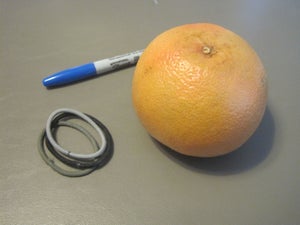
Credit: Evelyn Lamb
Instructions:
1. Draw three points on the grapefruit. For convenience, one of them should be the stem.
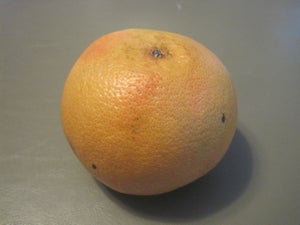
Credit: Evelyn Lamb
2. Put one elastic onto the grapefruit through the stem and one other point so it separates the grapefruit into two halves as symmetrically as possible. It might help to imagine that the grapefruit is a globe with the stem as the North Pole. Your elastic should be like a line of longitude, so it should go through the stem, one of the other two points, and the “South Pole” divot of the grapefruit.
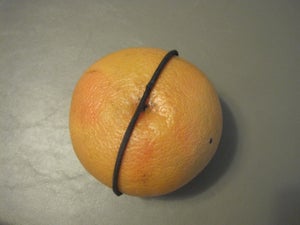
Credit: Evelyn Lamb
3. Put another elastic on the grapefruit through the stem and the third point on the grapefruit so it separates the grapefruit into two halves as symmetrically as possible.
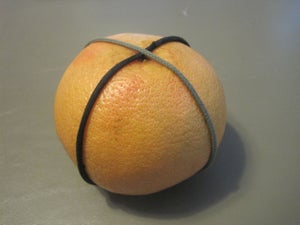
Credit: Evelyn Lamb
Before we add an elastic to make the last side, let’s pause and think about this figure. This is called a lune. I labeled the top angle α because mathematicians like to use Greek letters for angles.
.JPG?w=300)
Credit: Evelyn Lamb
The two elastics meet again at the South Pole of the grapefruit, and they’ll have the same angle there as they do at the top, so I’ve labeled that as well.
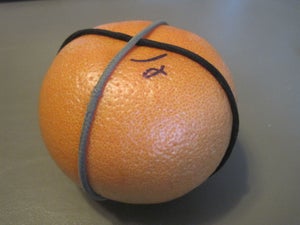
Credit: Evelyn Lamb
We’ll need to know the area of a lune later, so we’ll figure it out now. It’s not hard to see that the area of the lune should be proportional to the angle alpha. The surface area of the sphere is 4πr2. If we had an angle of π radians, or 180 degrees, the lune we got would be a hemisphere, and its area would be 2πr2. If we had an angle of π/2 radians or 90 degrees, we’d have a quarter of the entire sphere, so the area would be πr2. This pattern continues. The area of the lune is 2αr2, where α is the angle in radians.
Now we’re ready to add the third side of the triangle.
4. Put a third elastic on the grapefruit connecting the two unconnected points, once again trying to create halves that are as symmetrical as possible.
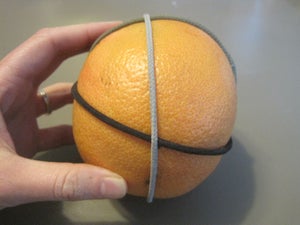
Credit: Evelyn Lamb
My grapefruit was not a perfect sphere, so the two "halves" aren't the same size for me. The more spherical the fruit, the closer you can get.
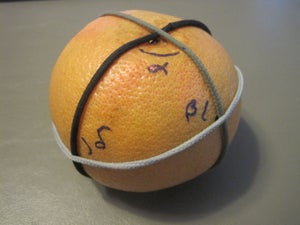
Credit: Evelyn Lamb
I labeled the other two angles beta and delta (because gamma looks too much like alpha).
Notice that there’s a matching triangle on the other side of the grapefruit with the same angles.
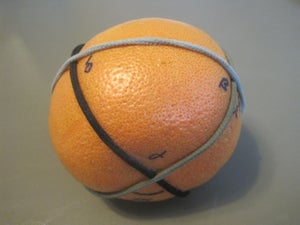
Credit: Evelyn Lamb
Now we have all the ingredients we need to figure out the area of the sphere. You can stop reading now and figure it out for yourself. If you get stuck, keep reading.
It's all about the lunes. When we put the three elastics on the triangle, we created two lunes with angle α, two with angle β, and two with angle δ. (We also created lunes with angles π-α, π-β, and π-δ, but we don't care about them.) By design, every point in the α-β-δ triangle we’re interested in is in one α lune, one β lune, and one δ lune, as is every point in the matching triangle on the bottom of the grapefruit. Every other point on the sphere is only in one of those lunes. If we add up the total area of the lunes, we'll count every point in either of those triangles three times instead of just once.
We can make these observations into a little algebraic equation. We'll let T be the area of the triangle. Remember from earlier that the area of the lune with angle α is 2αr2, and the area of the entire sphere is 4πr2. We get the equation:
4πr2=4αr2+4βr2+4δr2-4T
Unraveling that, we can solve to find that T=(α+β+δ-π)r2.
Questions to think about:
1. Can you see why the lune area pattern continues? Can you think of a way to convince a skeptical friend?
2. Why is every point that is not in one of the α-β-δ triangles only in one α, β, or δ lune? In other words, why is every point on the sphere in either one or three α, β, or δ lunes?
3. As a triangle on the sphere shrinks, its angles get smaller, and its angle sum gets closer and closer to π radians or 180 degrees, the angle sum of a triangle in Euclidean geometry. What does that have to do with your everyday life as a resident of a giant sphere?
